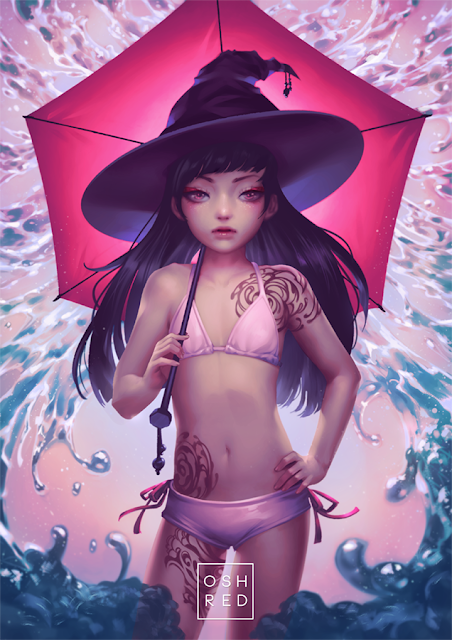marko djurdjevic analysis
Compositional storytelling and perspective
What i love about this piece, or really any of Marko's work is the amount of dynamic composition in the shots. What we see here from a perspective point of view is a one point perspective drawing with the perspective lines drawn like below we see hat they all converge to point back way over his head so we are underneath the horizon line, however he is not coming directly at us.
Instead it is slightly to the right, if we were to bisect the piece in half we would say the perspective of the axe would fall into the right 3rd of the image. This is where we get the biggest shape that sticks out at us which is the log he is breaking with his axe. Interesting then that he decides to connect both the log, his axe and the foot all into this one area since they all basically overlap with one another they all point at this area in the piece.
Compositionally it feels heavy on the bottom but the force he shows in the gesture of the figure going down and pulling back gives it a great asymmetrical design. Although we feel like everything is heavy on the bottom he intentionally makes his face and his whole body the focal point by letting his face and body be unabstracted by the background.
Force and convergence
Force could be say to be present all throughout this piece, there is a constant flowing swooping movements throughout the drawing underneath that guides our eye and gives some cohesion and rhythm to the piece while also providing convergence in the drawing. Ethan Becker says this is one of the keys to professional looking art that the forms themselves have shapes and lines that ultimately converge to a point although that doesn't mean that all shapes have to converge to the same point. Here I've shown what these swooping lines would look like for the entire piece as well as done a force breakdown of the gesture we see here.
Force Copy of gesture
Face copy
Once I broke down the head into its basic proportions I noticed that my proportions are way off. I have the tendency of making the head too thin, we can see on my 1st attempt that the left side of the drawing feels smashed the leveling of the ear is not correct completely either. I went back and did a second version but felt that there was no perspective in the facial features, the top eye needed to be moved up and the proportions of space between the features needed to change. Interestingly the shape of the head does not feel like it is going back in space but it is suggested this by how much of the temples which define the side planes we can see.
In my third attempt I pushed the space between the mouth and nose, while bringing the eyes and nose closer together. Also lengthening the jaw made this feel closer even though it is still off.
Form copy
I decided I would also copy some of the forms in the armor and turn them in different directions to understand the forms better. Taking a form like this and trying to replicate it from reference at different angles will help build your experience with learning and understanding form. Its interesting to me that he has a repeating pattern in the design of these forms with the front shapes creating a rectangular negative space at the front of the armor pieces. These also feel like they could pass for a spaceship design.

Color
I pulled some colors from the piece and laid them at the top and tried matching each one to try to understand his palette choice. What it looks like to me is is that it exists mostly in the red oranges and doesnt become too orange. This was my number one mistake that I made while trying to match each swatch of color, I consistently put too much orange into the piece instead of keeping it in the orange reds area. I also notice that in my own painting I seem to neglect the full range of the color picker, usually my colors fall into the top right or the left side of the piece, instead I will have to make sure to play with the darker mids that exist in between the most saturated and desaturated colors. With these he captures a lot of subtlety without the use of color contrast.
The contrast in this piece, is all about the values. I noticed this when picking his colors that he has no contrasting colors, this is instead a very limited palette that only draws red oranges, yellows, browns, and desaturated oranges. Instead we get a lighter value setup behind our figure which gives us a strong visual read of the image. This is typical of this kind of splash art. We see the darkest shapes concentrated in the foreground and midground while relegating the back colors to the lighter values to push the silhouette and the action moment he is in. High contrast in this context equals drama.








Comments
Post a Comment